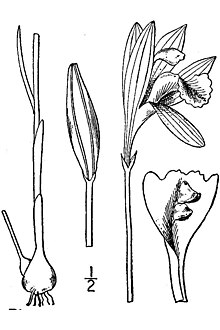Arethusa bulbosa
| Arethusa bulbosa | ||||||||||||
|---|---|---|---|---|---|---|---|---|---|---|---|---|

Arethusa bulbosa |
||||||||||||
| Systematics | ||||||||||||
|
||||||||||||
| Scientific name of the genus | ||||||||||||
| Arethusa | ||||||||||||
| L. | ||||||||||||
| Scientific name of the species | ||||||||||||
| Arethusa bulbosa | ||||||||||||
| L. |
The orchid Arethusa bulbosa is the only species in the genus Arethusa . The small, herbaceous tuber geophytes grow in the damp meadows and moors of North America.
description
The stem axis of Arethusa bulbosa forms underground storage organs. From this round, greenish tubers springing stems . On this is a single, linearly shaped leaf , up to 20 centimeters long and one centimeter wide. The leaf only develops after flowering . New tubers are formed on runners, the old one then dies. The plant is short-lived and only flowers a few years before it dies.
From each tuber one (rarely two) inflorescence grows, which carries a single (rarely two) flower. The height of the plant can be up to 40 centimeters. The flower color is purple, occasionally pink to white or bluish. Flowering time is from late May to June for southern populations, in the north to mid-July. The sepals are not fused together, their shape is oblong-oval, about two to 5.5 centimeters long and three to nine millimeters wide. You stand up straight. The petals are fused with each other and with the column , shape, size and color roughly correspond to the three outer petals. They are bent forward over the column. The elongated oval lip is indistinctly three-lobed. The lower part stands vertically upright and encompasses the column, the front part bends in a semicircle. The center of the lip shows darker reddish spots and stripes on a light pink to white background. From the base to the tip of the lip there are yellow, comb-like outgrowths. The column is long and curved, greatly broadened and winged at the top. The stamen sits on its underside, the column protrudes over the stamen. Four soft pollinia are formed, which are divided into numerous small pollen packets.
The yellow, stamen-like trichomes on the colored lip attract pollinators. Queens of the bumblebee species Bombus ternarius and Bombus terricola were observed ; pollen sticks to the thorax . There are different observations on the question of whether nectar is produced or whether the pollinating insects are deceived.
The fruit is an oval, upright capsule , about 1.5 to 2.5 centimeters in size.
The number of chromosomes is 2n = 40.
distribution
Arethusa bulbosa grows in north-eastern North America at altitudes from 0 to 1600 meters. In Canada, their occurrences range from the southeast to central Manitoba and northwest Saskatchewan . In the USA, the northeast is populated, in the high altitude of the Appalachian Mountains , the occurrences extend further south.
The locations are moors and swamps, moist coniferous forests, river banks and wet meadows. Sunny locations are preferred, in the south of the range the plants also grow in the shade of rhododendron bushes. Two other orchids that coexist with Arethusa bulbosa are Calopogon tuberosus and Pogonia ophioglossoides . Of these three, Arethusa prefers the wettest locations. In culture, hybrids between Arethusa bulbosa and Calopogon tuberosus have arisen, but they are not known from nature because the flowering time of Calopogon is later.
use
Earlier use of the tubers as medicine is reported. This orchid is rarely seen in cultivation because it is short-lived, places special demands on the substrate and the tubers can rot quickly.
Systematics
Within the subfamily Epidendroideae , the genus Arethusa is classified in the tribe Arethuseae and there in the subtribe Arethusinae . Arethusa is related to the Asian genus Eleorchis and the genus Calopogon occurring in North America , the other genera of the subtribe occur in East Asia.
The generic name Arethusa refers to the nymph Arethusa from Greek mythology. The Dutch botanist Jan Frederik Gronovius chose the name when he described this orchid. Carl von Linné then took it over in 1753 in his work Species Plantarum . The epithet bulbosa refers to the subterranean, bulbous storage organs.
Individual evidence
- ^ Canadian Native Orchids Online, accessed February 5, 2008
- ^ Carlyle A. Luer: The Native Orchids of the United States and Canada (excluding Florida) . The New York Botanical Garden (1975)
- ↑ Carl von Linné: Species plantarum . Stockholm, 1753. Online, accessed February 14, 2008
literature
- Alec M. Pridgeon, Phillip Cribb, Mark W. Chase: Genera Orchidacearum . Vol. 4/1: Epidendroidae (Part one) . Oxford University Press, Oxford 2005, pp. 14-17. ISBN 0-19-850712-7
- Charles J. Sheviak, Paul M. Catling: Arethusa. In: Flora of North America Editorial Committee (Ed.): Flora of North America North of Mexico . New York / Oxford 26.1993, p. 596. Retrieved February 5, 2008.
